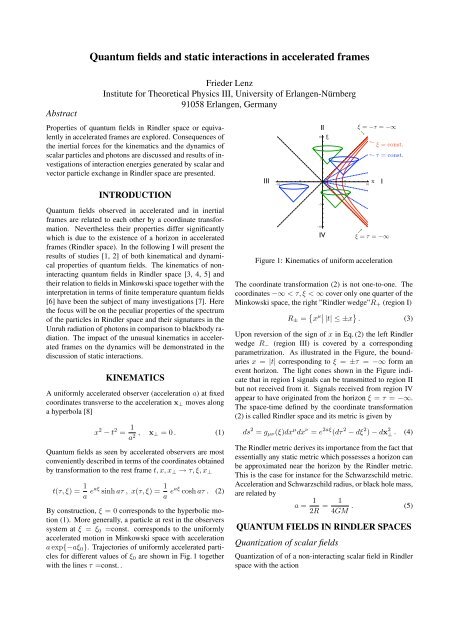Proceedings of International Conference on Physics in ... - KEK
Proceedings of International Conference on Physics in ... - KEK
Proceedings of International Conference on Physics in ... - KEK
You also want an ePaper? Increase the reach of your titles
YUMPU automatically turns print PDFs into web optimized ePapers that Google loves.
Abstract<br />
Quantum fields and static <strong>in</strong>teracti<strong>on</strong>s <strong>in</strong> accelerated frames<br />
Frieder Lenz<br />
Institute for Theoretical <strong>Physics</strong> III, University <str<strong>on</strong>g>of</str<strong>on</strong>g> Erlangen-Nürnberg<br />
91058 Erlangen, Germany<br />
Properties <str<strong>on</strong>g>of</str<strong>on</strong>g> quantum fields <strong>in</strong> R<strong>in</strong>dler space or equivalently<br />
<strong>in</strong> accelerated frames are explored. C<strong>on</strong>sequences <str<strong>on</strong>g>of</str<strong>on</strong>g><br />
the <strong>in</strong>ertial forces for the k<strong>in</strong>ematics and the dynamics <str<strong>on</strong>g>of</str<strong>on</strong>g><br />
scalar particles and phot<strong>on</strong>s are discussed and results <str<strong>on</strong>g>of</str<strong>on</strong>g> <strong>in</strong>vestigati<strong>on</strong>s<br />
<str<strong>on</strong>g>of</str<strong>on</strong>g> <strong>in</strong>teracti<strong>on</strong> energies generated by scalar and<br />
vector particle exchange <strong>in</strong> R<strong>in</strong>dler space are presented.<br />
INTRODUCTION<br />
Quantum fields observed <strong>in</strong> accelerated and <strong>in</strong> <strong>in</strong>ertial<br />
frames are related to each other by a coord<strong>in</strong>ate transformati<strong>on</strong>.<br />
Nevertheless their properties differ significantly<br />
which is due to the existence <str<strong>on</strong>g>of</str<strong>on</strong>g> a horiz<strong>on</strong> <strong>in</strong> accelerated<br />
frames (R<strong>in</strong>dler space). In the follow<strong>in</strong>g I will present the<br />
results <str<strong>on</strong>g>of</str<strong>on</strong>g> studies [1, 2] <str<strong>on</strong>g>of</str<strong>on</strong>g> both k<strong>in</strong>ematical and dynamical<br />
properties <str<strong>on</strong>g>of</str<strong>on</strong>g> quantum fields. The k<strong>in</strong>ematics <str<strong>on</strong>g>of</str<strong>on</strong>g> n<strong>on</strong><strong>in</strong>teract<strong>in</strong>g<br />
quantum fields <strong>in</strong> R<strong>in</strong>dler space [3, 4, 5] and<br />
their relati<strong>on</strong> to fields <strong>in</strong> M<strong>in</strong>kowski space together with the<br />
<strong>in</strong>terpretati<strong>on</strong> <strong>in</strong> terms <str<strong>on</strong>g>of</str<strong>on</strong>g> f<strong>in</strong>ite temperature quantum fields<br />
[6] have been the subject <str<strong>on</strong>g>of</str<strong>on</strong>g> many <strong>in</strong>vestigati<strong>on</strong>s [7]. Here<br />
the focus will be <strong>on</strong> the peculiar properties <str<strong>on</strong>g>of</str<strong>on</strong>g> the spectrum<br />
<str<strong>on</strong>g>of</str<strong>on</strong>g> the particles <strong>in</strong> R<strong>in</strong>dler space and their signatures <strong>in</strong> the<br />
Unruh radiati<strong>on</strong> <str<strong>on</strong>g>of</str<strong>on</strong>g> phot<strong>on</strong>s <strong>in</strong> comparis<strong>on</strong> to blackbody radiati<strong>on</strong>.<br />
The impact <str<strong>on</strong>g>of</str<strong>on</strong>g> the unusual k<strong>in</strong>ematics <strong>in</strong> accelerated<br />
frames <strong>on</strong> the dynamics will be dem<strong>on</strong>strated <strong>in</strong> the<br />
discussi<strong>on</strong> <str<strong>on</strong>g>of</str<strong>on</strong>g> static <strong>in</strong>teracti<strong>on</strong>s.<br />
KINEMATICS<br />
A uniformly accelerated observer (accelerati<strong>on</strong> a) at fixed<br />
coord<strong>in</strong>ates transverse to the accelerati<strong>on</strong> x⊥ moves al<strong>on</strong>g<br />
a hyperbola [8]<br />
x 2 − t 2 = 1<br />
a 2 , x⊥ = 0 . (1)<br />
Quantum fields as seen by accelerated observers are most<br />
c<strong>on</strong>veniently described <strong>in</strong> terms <str<strong>on</strong>g>of</str<strong>on</strong>g> the coord<strong>in</strong>ates obta<strong>in</strong>ed<br />
by transformati<strong>on</strong> to the rest frame t, x, x⊥ → τ, ξ, x⊥<br />
t(τ, ξ) = 1<br />
a eaξ s<strong>in</strong>h aτ , x(τ, ξ) = 1<br />
a eaξ cosh aτ . (2)<br />
By c<strong>on</strong>structi<strong>on</strong>, ξ = 0 corresp<strong>on</strong>ds to the hyperbolic moti<strong>on</strong><br />
(1). More generally, a particle at rest <strong>in</strong> the observers<br />
system at ξ = ξ0 =c<strong>on</strong>st. corresp<strong>on</strong>ds to the uniformly<br />
accelerated moti<strong>on</strong> <strong>in</strong> M<strong>in</strong>kowski space with accelerati<strong>on</strong><br />
a exp{−aξ0}. Trajectories <str<strong>on</strong>g>of</str<strong>on</strong>g> uniformly accelerated particles<br />
for different values <str<strong>on</strong>g>of</str<strong>on</strong>g> ξ0 are shown <strong>in</strong> Fig. 1 together<br />
with the l<strong>in</strong>es τ =c<strong>on</strong>st. .<br />
II<br />
t<br />
10<br />
5<br />
+<br />
III x I<br />
10 5 5 10<br />
5<br />
10<br />
IV<br />
→<br />
ξ = −τ = −∞<br />
→<br />
←<br />
ξ = c<strong>on</strong>st.<br />
← τ = c<strong>on</strong>st.<br />
ξ = τ = −∞<br />
Figure 1: K<strong>in</strong>ematics <str<strong>on</strong>g>of</str<strong>on</strong>g> uniform accelerati<strong>on</strong><br />
The coord<strong>in</strong>ate transformati<strong>on</strong> (2) is not <strong>on</strong>e-to-<strong>on</strong>e. The<br />
coord<strong>in</strong>ates −∞ < τ, ξ < ∞ cover <strong>on</strong>ly <strong>on</strong>e quarter <str<strong>on</strong>g>of</str<strong>on</strong>g> the<br />
M<strong>in</strong>kowski space, the right ”R<strong>in</strong>dler wedge”R+ (regi<strong>on</strong> I)<br />
R± = x µ |t| ≤ ±x . (3)<br />
Up<strong>on</strong> reversi<strong>on</strong> <str<strong>on</strong>g>of</str<strong>on</strong>g> the sign <str<strong>on</strong>g>of</str<strong>on</strong>g> x <strong>in</strong> Eq. (2) the left R<strong>in</strong>dler<br />
wedge R− (regi<strong>on</strong> III) is covered by a corresp<strong>on</strong>d<strong>in</strong>g<br />
parametrizati<strong>on</strong>. As illustrated <strong>in</strong> the Figure, the boundaries<br />
x = |t| corresp<strong>on</strong>d<strong>in</strong>g to ξ = ±τ = −∞ form an<br />
event horiz<strong>on</strong>. The light c<strong>on</strong>es shown <strong>in</strong> the Figure <strong>in</strong>dicate<br />
that <strong>in</strong> regi<strong>on</strong> I signals can be transmitted to regi<strong>on</strong> II<br />
but not received from it. Signals received from regi<strong>on</strong> IV<br />
appear to have orig<strong>in</strong>ated from the horiz<strong>on</strong> ξ = τ = −∞.<br />
The space-time def<strong>in</strong>ed by the coord<strong>in</strong>ate transformati<strong>on</strong><br />
(2) is called R<strong>in</strong>dler space and its metric is given by<br />
ds 2 = gµν(ξ)dx µ dx ν = e 2aξ (dτ 2 − dξ 2 ) − dx 2 ⊥ . (4)<br />
The R<strong>in</strong>dler metric derives its importance from the fact that<br />
essentially any static metric which possesses a horiz<strong>on</strong> can<br />
be approximated near the horiz<strong>on</strong> by the R<strong>in</strong>dler metric.<br />
This is the case for <strong>in</strong>stance for the Schwarzschild metric.<br />
Accelerati<strong>on</strong> and Schwarzschild radius, or black hole mass,<br />
are related by<br />
a = 1 1<br />
= . (5)<br />
2R 4GM<br />
QUANTUM FIELDS IN RINDLER SPACES<br />
Quantizati<strong>on</strong> <str<strong>on</strong>g>of</str<strong>on</strong>g> scalar fields<br />
Quantizati<strong>on</strong> <str<strong>on</strong>g>of</str<strong>on</strong>g> <str<strong>on</strong>g>of</str<strong>on</strong>g> a n<strong>on</strong>-<strong>in</strong>teract<strong>in</strong>g scalar field <strong>in</strong> R<strong>in</strong>dler<br />
space with the acti<strong>on</strong>













